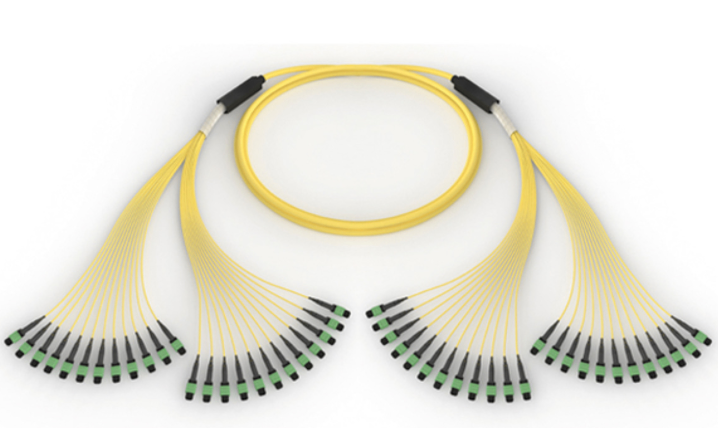Oufu Optical Fiber Cable Co.,Ltd
Atsetur: Shenyang, Liaoning, Kina
Kontakt persóna: Zhang-føðing
Telefon: 400-964-134
Mobile telefon: 86 1390405338
Himp
2025-09-15 986

Indoor round fiber ribbon cable features a unique construction that stacks multiple fiber ribbons within a circular protective jacket. The typical configuration includes 12-fiber ribbons organized in concentric layers around a central strength member. The cable structure consists of: optical fibers arranged in ribbon matrix, water-blocking elements, strength members (typically aramid yarn or fiberglass rods), and a LSZH (Low Smoke Zero Halogen) jacket that meets UL 1666 plenum rating requirements. This design provides both high fiber count and excellent fire safety characteristics for indoor applications.
Indoor round fiber ribbon cable offers several significant benefits that make it particularly suitable for contemporary network deployments. The round design provides better mechanical protection than flat alternatives, with improved crush resistance and tensile strength. These cables maintain all the splicing advantages of ribbon technology, allowing mass fusion splicing of up to 12 fibers simultaneously. They offer superior pathway utilization in standard circular conduits and cable trays. The design also ensures better fiber management at termination points, with organized ribbon stacking that simplifies identification and connectivity.
Proper installation is crucial for optimal performance of indoor round fiber ribbon cable. Begin with careful cable handling - always maintain the minimum bend radius (typically 20 times the cable diameter) and avoid twisting during pulling. Use appropriate tension monitoring equipment, never exceeding the maximum pulling tension (usually 100-150 pounds for most indoor cables). For termination, use ribbon-specific stripping tools that preserve the ribbon matrix integrity. When splicing, employ mass fusion splicers specifically calibrated for ribbon fibers, ensuring proper electrode cleaning and arc calibration. Finally, implement comprehensive testing including insertion loss measurements with an OLTS and fault location with OTDR when necessary.
⚠️ Critical Warning: These errors can cause significant performance issues
Avoid using conventional cable ties that can deform the cable structure - instead use specially designed ribbon cable ties that distribute pressure evenly. Never exceed the recommended bend radius, particularly at corner points and termination areas. Don't attempt to separate ribbons without proper tools - this can cause fiber microcracks and increased attenuation. Ensure proper strain relief at all termination points to prevent stress on fibers. Interestingly, most performance issues arise not from the splicing process itself but from improper cable handling during installation.
| Parameter | Round Ribbon Cable | Flat Ribbon Cable |
|---|---|---|
| Mechanical Protection | Superior crush resistance | Moderate protection |
| Pathway Compatibility | Excellent in circular conduits | Requires flat-specific pathways |
| Handling Characteristics | Familiar to installers | Special handling required |
| Splicing Efficiency | Identical mass splicing capability | Identical mass splicing capability |
| Minimum Bend Radius | Larger radius required | Smaller radius acceptable |
During a recent data center expansion project, our team deployed indoor round fiber ribbon cable to connect 48 server racks with 432 fiber connections. The round design allowed easy installation through existing circular conduits that would have been incompatible with flat ribbon cables. Using mass fusion splicing, we completed the entire termination process in just four days instead of the projected three weeks. The installation achieved consistent performance with average insertion loss of 0.32 dB and zero fiber breaks despite multiple 90-degree bends in the pathway.
Monthly visual inspection for jacket integrity and deformation
Quarterly cleaning of all connectors and patch panels
Bi-annual insertion loss testing with documented results
Annual inspection of all splicing points and strain reliefWww.adsscable.cn
Verification of cable management and bend radius compliance
Documentation updates after any modifications
Emergency repair kit maintenance and inventory check
Can indoor round fiber ribbon cable be used in plenum spaces?
Yes, most manufacturers offer plenum-rated versions that meet NEC 770 requirements for use in air handling spaces without conduit.
What is the maximum fiber count available in round ribbon format?
Currently available configurations range from 72 to 864 fibers, with higher counts typically used in data center applications.
Www.adsscable.cn
Do I need special training to install these cables?
While the round form factor is familiar, installers require specific training in ribbon handling and mass fusion splicing techniques.
How does the cost compare to traditional loose tube cables?
The initial cable cost is higher but total installed cost is typically 30-40% lower due to reduced splicing time and labor.
Www.adsscable.cn
Can I mix ribbon and conventional cables in the same network?
Yes, with appropriate transition enclosures that allow individual fiber management at interconnection points.
Indoor round fiber ribbon cable technology represents an optimal solution for high-density indoor applications, combining the best features of ribbon technology with familiar round cable characteristics. By following these guidelines and best practices, network operators can achieve reliable, high-performance fiber installations that support current and future bandwidth requirements.